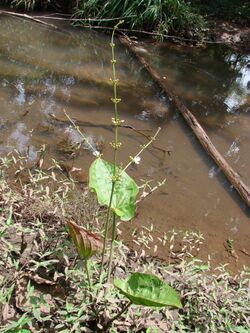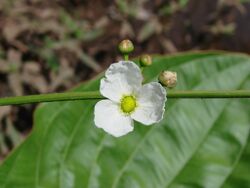Echinodorus macrophyllus
Topic: Biology
 From HandWiki - Reading time: 3 min
From HandWiki - Reading time: 3 min
| Echinodorus macrophyllus | |
|---|---|

| |
| Scientific classification | |
| Kingdom: | Plantae |
| Clade: | Tracheophytes |
| Clade: | Angiosperms |
| Clade: | Monocots |
| Order: | Alismatales |
| Family: | Alismataceae |
| Genus: | Echinodorus |
| Species: | E. macrophyllus
|
| Binomial name | |
| Echinodorus macrophyllus Micheli
| |
| Synonyms[1] | |
| |
Echinodorus macrophyllus is a species of aquatic plants in the Alismataceae. It is native to Brazil and Bolivia.[1][2]
Description
Petioles 2 - 3 x longer than the blade, membraneously alate on the base, thin to densely pilose under the blade. Pubescence simple or stellate and absent on young or submerged plants. Blade membraneous, sagittato-cordate or triangularly obovate with long blunt lobes, approximately as wide as the midrib length and widest at the base. Blade (6.5) - 20 – 30 cm long and (7_ - 20 – 30 cm wide with 11 - 13 veins (7 - 15 are possible). No pellucid markings.
Stem upright, about twice as long as the leaves, cylindrical, between the whorls triangular, pubescent under whorls as well as petioles.[3][4][5]
Inflorescence rarely racemose, usually paniculate having 6 - 13 whorls containing 6 - 9 flowers each. Bracts lanceolate, densely ribbed. Bracts in the first whorl as long as the pedicels, in the other whorls they are a third shorter. Pedicels 1 - 3.5 cm long, sepals broadly ovate, leather-like, densely ribbed, 5 – 6 mm long, petals white, obovate, 15 – 18 mm long, stamens 20 - 24, filaments longer than the anthers, pistils numerous, style longer than the ovary.[citation needed]
Aggregate fruit globular, echinate, 6 – 8 mm in diameter. Achenes flat, subovately-cuneate, 3 x 1.5 mm with 3 - 5 (usually 3) lateral ribs and 2 - 3 oblong and further 3 - 5 small round glands. Stylar beak usually straight, approximately 0.75 mm.[citation needed]
Cultivation
Grow at tropical temperatures with plenty of light and a rich substrate. It can stand lower temperatures however if acclimatised, though it will stay rather smaller and grow more slowly. Water conditions don't seem to be critical. In the smaller aquarium it will often quickly form emerse leaves, which prefer moist conditions and don't like being dried out by being too near lamps etc. It is easy to grow and makes a very good specimen plant for the larger aquarium.[citation needed]
Medicinal
It is suitable for aquariums and ornamental, and also medicinal use. The infusion tea leaf provides laxative. A survey has confirmed its effectiveness in cases of hypertension.[3] It is also popularly used as a diuretic and antirheumatic against inflammation of skin and throat, rheumatism, arthritis and syphilis as blood purifier and eliminator of uric acid. The plant produces a rhizome which a mass is extracted. This mass can be made sweet, like pumpkin. This candy is very good as blood cleanser.[citation needed]
The plant is used in the production of Brazilian soft drinks Mineirinho and Mate.[citation needed]
References
- ↑ 1.0 1.1 "World Checklist of Selected Plant Families: Royal Botanic Gardens, Kew" (in en-GB). http://apps.kew.org/wcsp/namedetail.do?name_id=305282.
- ↑ Forzza, R. C. 2010. Lista de espécies Flora do Brasil "Archived copy". Archived from the original on 2015-09-06. https://web.archive.org/web/20150906080403/http://floradobrasil.jbrj.gov.br/2010/. Retrieved 2015-08-20.. Jardim Botânico do Rio de Janeiro, Rio de Janeiro
- ↑ 3.0 3.1 de, Candolle, Alphonse; de, Candolle, Casimir (1881-01-01) (in en). Monographiæ phanerogamarum. 3. https://www.biodiversitylibrary.org/page/32080989#page/53/mode/1up.
- ↑ Rataj, Karel. 1988. The beautiful Echinodorus macrophyllus. TFH 7/88.
- ↑ Killeen, T. J. & T. S. Schulenberg. 1998. A biological assessment of Parque Nacional Noel Kempff Mercado, Bolivia. RAP Working Papers 10: 1–372.
External links
Wikidata ☰ Q3006324 entry
 |
 KSF
KSF
